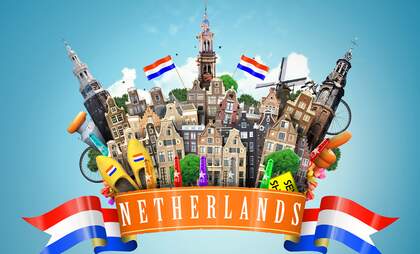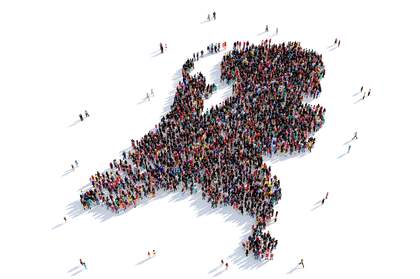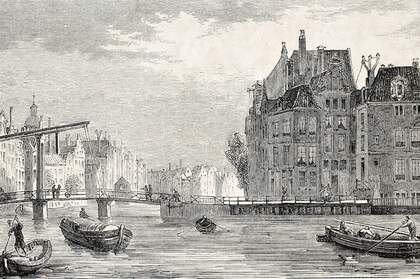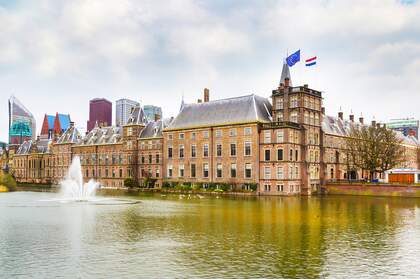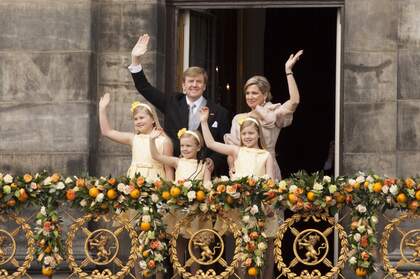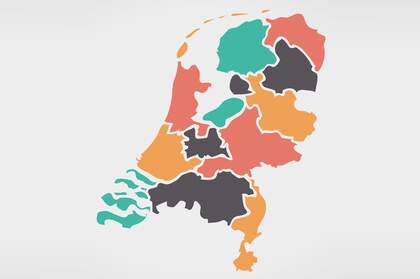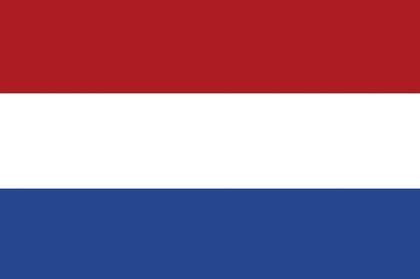- The flag of the Netherlands is red, white and blue; just turn the French one 90 degrees to the left.
- Orange is the Netherlands' national colour because of the house of Orange, the Dutch royal line.
- The Netherlands is one of the best countries for children to live in (2007 Unicef report).
- The Netherlands has the highest concentration of museums in the world. Some of the most famous Dutch painters are Rembrandt, Vermeer, Steen, van Gogh and Mondrian.
- Holland is a geographic part of the Netherlands referring to the western part of the country (e.g. Amsterdam, Rotterdam, The Hague).
- Amsterdam has 1.281 bridges and is entirely built on piles.
- The Netherlands' highest point is 322,7 metres above sea level (Vaalserberg) and the lowest 6,76 metres below sea level (Prince Alexander Polder).
- The Netherlands is one of the most densely populated countries in the world.
- The voltage used in the Netherlands is 220, 50 cycle AC.
- Most cities and villages have at least one tourist information office (VVV sign) that provides maps and brochures for free.
- The tap water is of excellent quality.
- Every city has its own opening hours for shopping on Sundays.
- VAT is already included in quoted prices.
- Only some 100 years ago the central Netherlands still had sand deserts.
- Places of worship can be found all around the country even though the Dutch are quite secular; only 20 percent of them attend services on a regular basis.
- In the Netherlands there are twice as many bikes as cars with over 15.000 km of cycle tracks.
The Dutch: Interesting facts & figures
- Statistically, Dutch are among the tallest people in Europe.
- Eye contact and criticism are to be expected when chatting with a Dutch.
- The Netherlands has the highest number of part-time workers in the EU (four out of 10 employees).
- One out of three Dutch belongs to a sports club.
- Almost all Dutch people can swim, skate and ride a bike.
- The Dutch always consult their agenda and do not appreciate "surprise" visits.
- They are the world's second biggest coffee drinkers.
- The Dutch are not conversation-starters. However, they will respond immediately and rather eagerly when addressed.
- Dutch citizens take their own bags to the supermarket to pack their groceries.
- When you introduce yourself, always state both first and last name and shake hands with everyone in the room.
- Dutch ladies have to get kissed three times (right-left-right) on the cheek. Expats may get by with shaking hands though.
- The Dutch enjoy one of the longest average life spans in the world.
- Congratulating your Dutch friend for his / her birthday is more than expected.
Business facts about the Dutch & the Netherlands
- The Dutch were the first Europeans to discover Australia and New Zealand.
- The Netherlands is the fourth largest investor in the US.
- In 1667 the Dutch exchanged the Dutch possession of New Amsterdam (later called New York) for the South American colony of Suriname.
- The Netherlands is the world’s first producer and exporter of tulips.
- Dutch inventions include the compact disc, microscope, telescope, mercury thermometer and artificial heart.
- The Netherlands is the third largest agricultural exporter in the world. In fact, NL is the world's main producer of peppers, tomatoes and cucumbers.
- Rotterdam seaport is the world’s second largest port in size and tonnage (after Singapore since 2005).
- The first wooden shoes were made here. The Netherlands has plenty of water so people wanted shoes that would keep their feet dry while working outside.
- The Hague is dubbed "the legal capital of the world" since five international courts are located nearby: International Court of Justice, Permanent Court of Arbitration, International Criminal Tribunal for the former Yugoslavia, International Criminal Court, Special Tribunal for Lebanon
- More than 80 international organisations and NGOs are located in the Hague.
- Famous Dutch companies: Philips (inventor of the audio tape, videotape, compact disk and CD-ROM), Royal Dutch Shell, Heineken, Amstel, Bavaria, DSM, Akzo Nobel, KPMG, Unilever and ING.
Did you know that?
- Words such as "dollar" and "Yankee" have Dutch roots - just like 4,5 million Americans.
- Same-sex marriage and euthanasia are legal (since 2001 and 2002 respectively).
- Prostitution is considered legal as long as prostitutes are at least 18 and clients at least 16 years old.
- Only coffee shops are allowed to sell soft drugs. Citizens can grow their own though.
- Orange carrots were bred in the Netherlands in the 16th century in honour of the house of Orange. Before then they were white, yellow, black, purple or red.
- Although the Dutch language is taught at more than 250 universities worldwide, in the province of Friesland, locals speak Frisian, their own language.
- The Netherlands is a founding member of NATO, the EU and the OECD.
- Royal House members have to acquire an official approval by the parliament in order to get married. If not, they lose the right to succeed to the throne.
- A Dutch wedding can consist of either a civil ceremony (by a local official at a town hall) or a wedding in a church or other location. Regardless of location, unions must be registered with the local town hall (gemeente) to be recognised as legal marriage in the Netherlands.
- The Homomonument in Amsterdam is the world’s first public memorial to persecuted gays and lesbians.
- Around 9 percent of marriages in the Netherlands are same-sex.
- Every New Year’s Eve, fireworks worth around 65 million euros are consumed.
- The Dutch healthcare system is (considered) one the best in the world.
- May 4 is the day when Dutch victims of war are remembered and at 8pm, a two-minute silence is observed nationally.
- The Dutch monarch's birthday has been an officially celebrated since 1898 (Queen Wilhelmina’s 18th birthday). Queen Juliana (1948-1980) changed the date to her own birthday (April 30) whereas Princess Beatrix (1980-2013) celebrated her birthday on April 30, despite the fact that she was born on January 31. King Willem-Alexander (2013-present) celebrates his birthday and King's Day (koningsdag) on April 27.
- The Netherlands is the only country with a national dog.
- There was a time when the Spanish Inquisition condemned the entire nation of the Netherlands to death for heresy.
- Sinterklaas and Santa Claus are not the same person! Sinterklaas, his white horse and his helpers (Zwarte Pieten or Black Petes) arrive from the south of Spain on a steamboat.
- Since January 1, 2014, one has to be aged 18 or older to purchase alcohol, cigarettes or soft drugs.
- As a rule, public consumption of soft drugs is unacceptable.
- Dutch police are not obliged to grant a phone call to those they detain.
- The Dutch were the first to officially recognise nationhood of the United States.
The Netherlands & Water
The Netherlands’s relationship with water is unlike that of any other country in the world. Here are some interesting facts and figures about how water has shaped the Dutch landscape, culture and lifestyle.
- One third of the Dutch territory, roughly speaking, is actually below sea level, while another one third is very close to the official zero-measuring (NAP) level.
- N.A.P. (Normal Amsterdam Level) is the level between average high tide and average low tide, and the standard to which all lows and highs in the country are measured. NAP is even referred to as the "European Ordnance Level."
- Along waterways throughout the Netherlands are some 50.000 indicators of NAP.
- Most windmills were simply wind-driven pumps. Nowadays, they been replaced by electric pumping stations but still almost 1.000 (out of the estimated 10.000 in the 17th century) remain.
- Dikes were made of soil and later from rock (especially basalt). Today, even though modern materials (concrete, asphalt etc.) are used, parts of dikes are still made with the original ones.
- If a dike breaks, only a restricted area - a so-called "dike ring" - would be flooded. But if for some reason, all dikes would break simultaneously, roughly one half of the Netherlands would be flooded.
- To find out if your home is below sea level, and by how much, you can visit the Actueel Hoogtebestand Nederland (AHN) and enter your postcode.
- Downtown Amsterdam lies some 2 metres (6,5 ft) above sea level.
- Schiphol is the world’s lowest-lying airport. In fact, the NS station at Schiphol lies 10 metres (32 feet) below sea level.
- The main purpose of ditches is drainage. Of course, they are meant for dividing fields and properties, and keeping cattle in place too.
- Ditches are connected to a wider water mass and eventually, the water will be discharged into a river or canal and hence to the sea. At least half of the Netherlands could not even exist without those ditches.
- Statistically there are 125 days per year without a drop of rain anywhere in the country.
- Per person, the Dutch use 120 litres (26 gallons) of clean water everyday for various reasons.
- Dutch drinking water goes through some 20 steps of purification before reaching your tap.
- In the past, the miller and his family could communicate news (birth, death, marriage etc.) without leaving the windmill, by positioning the wings in a certain way.
- Usually wooden shoes were made of willow trees. They provide insulation and are impenetrable, not only to water but also to sharp farmers’ tools. Dutch farmers ofter wore a kind of inside-shoe in them; pluck or straw for the poor, but soft and flexible goat leather "clog socks" for the well-to-do.
- Most types of bridges can be found in the Netherlands, the main exception being rope-bridges.
- "The (balancing) bridge was open" is considered the traditional Dutch excuse for being late.
- "Canal" or gracht is related to the English word "grave." Canals in the Netherlands were made for defence and transportation.
- The Dutch tend to call any elevation in their flat environment a berg or at least a bergje - a small mountain or rather a mound, also when it is just one meter (3,3 ft) high.
- No matter the economic climate, cutting the budget for maintenance of dikes in never ever debated.
- The mix of sand and clay was known to be perfect for agriculture when tulips were introduced to the Dutch Republic in the 17th century.
- On cycling paths in sandy areas all over the country, seashells are used for "pavement." Preventing both mud and dust, the crushed shells guarantee good passage in wet as well as in very dry weather.
- The Dutch use the word "sea" (zee), and not "ocean." They feel that the ocean is far away, behind the the British Isles.
- The dunes are Holland’s natural protection against the sea. That is why admission is restricted in most places.
- Sea-water temperatures may reach 20C (68F) by late August but will be down again to just 4C (39F) by February.
- On the beach, semi-nudity is widely accepted. Of course, there are also official nude beaches with signs saying "Naaktstrand."
- Living safely below sea level costs everyone residing in the Netherlands some 330 dollars per year.
- Too little water can also be a problem; with many old dikes built of clay and peat drought can cause a dike to dry out and start cracking.
- In Dutch, bricks are called baksteen (bake-stone), and that is what they are: baked from river clay.
- The Elfstedentocht, the "Eleven City Tour," is a one-day skating event that starts and end in the provincial capital of Leeuwarden. An almost 200km (124mi) race that started in 1909 and has been followed by 14 other ones so far.
- Waterschap, the regional water control board, is the oldest-existing democratic "body" in the Netherlands, dating back to the 13th century. There are 27 waterschappen today.
- Holland’s soft subsoil has a great advantage; All cables, tubes and pipes can be neatly hidden underground. Have you seen any telephone poles around?
- There are some 10.000 houseboats in the Netherlands and over 2.400 in Amsterdam alone, even when only a third of these are on the picturesque city centre canals. Note that one of them has been sitting in precisely the same location in Amsterdam since 1888!
- Amsterdam authorities want to gradually reduce the number of houseboats. As a result, when houseboat dwellers move out or die, permits are often not renewed, and the number of houseboats will eventually decrease.
- The first areas with "biological" agriculture in the Netherlands were set up in the 1970s.
- Amsterdam’s drinking water system was the first of the country, dating back to 1853.. 70% of the water comes from the Rhine river and the remaining 30% from a polder (a reclaimed catchment area) in Loosdrecht lake area.
- Parts of the Dutch landscape became low due to human intervention. When settlement started long ago, people stuck to higher spots such as river levees, the slopes of the dunes and an occasional elevation. Between these was the wet wasteland, full of growth and wood, or holt - therefore "Holt-land," or Holland. By conquering this, i.e. Pumping it dry, digging away the peat and then using it for agriculture, the land got lower and lower.
- Amsterdam grew around a 13th century dam in the Amstel river, its most famous and striking feature is its canals (grachten), which gave the city the nickname "Venice of the North" and, in 2010, also Unesco World Heritage status.
- The Central Station in Amsterdam stands in front of what used to be the Amstel river’s natural outlet into the IJ.
- "Flushing" the canals is done at night, twice a week under normal conditions and four times in period of hot weather. Flushing is done by opening Amsterdam’s system of sluices in such way that fresh Amstel water pushes the "older" water out into the IJ.
- Some buildings can be seen tilting. If the tilt is forward, there is nothing to worry about; it was done on purpose when the house was built, to make rainwater drip from the wooden windowsills in order to preserve them and perhaps also to keep furniture being hoisted up the facade from hitting the building. If the tilt is sideways, however, it indicates a serious condition.
- The "palace" on Dam Square (built around 1650) sits on no less than 13.659 poles driven into the soft river ground.
- Just like Amsterdam, many towns have a Dam square, situated at some distance inland from the tidal waters leading to the sea, since the river mouth could function as a protected harbour.
- Even though tulips originate in the dry and cold mountains of Turkey, they grow best on a special kind of soil behind the dunes that is a mix of sea sands and more fertile clay.
- Keukenhof means "kitchen garden," originally being a castle garden where vegetables and herbs were grown for the kitchen. It was turned into a more formal garden in the 1850s, and by 1949 into the now-famous annual flower show.
- The world’s earliest public transport could be found in the 17th century Dutch Republic, where passenger boats would leave for certain destinations at fixed hours, and people would know the arrival time at their destination.
These and many more interesting facts can be found at "The Dutch and their Delta: Living below sea level" written by Jacob Vossestein and published by XPat Media.

